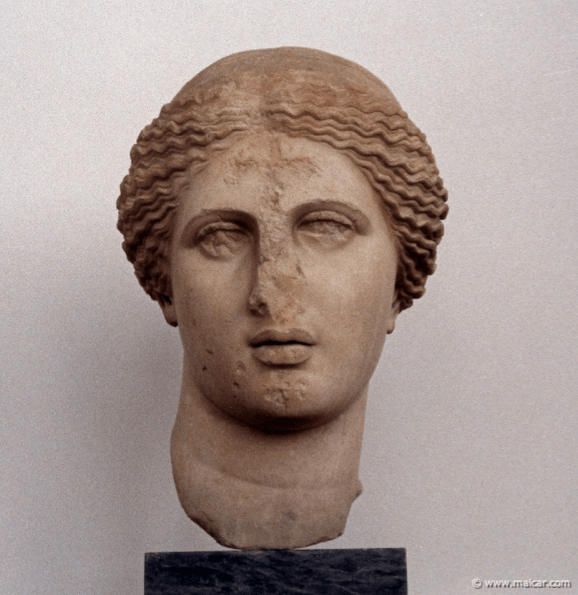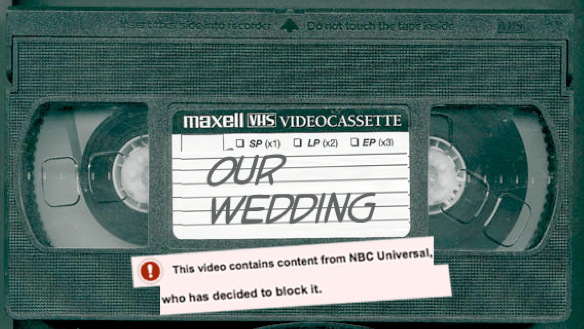Border Patrol
By:
September 20, 2011
This post is part of Border Town Online, a digital complement to the Border Town Design Studio which will be on display in Detroit starting on September 21st. You can find the rest of the posts at dividedcities.com.
Several years ago I was invited by an acquaintance to dinner. In the entryway of their apartment was a large color photograph of a naked woman in a classic pinup pose. The photo would have been sexy in that vintage girl-next-door way, shot against a soft pale-blue background, hands up to her head gently holding back a cascade of natural blond hair. But instead of a soft pouty expression, the woman’s hair framed a gaping, empty hole, which echoed the large white punches made in her chest and the wide white circle between her legs.
I didn’t know our host well enough to comment until later in the evening, when I learned the image was part of a collection his grandfather had. Apparently, working at a mail-order photo-processor, it was his grandfather’s job to work as censor. Using a strict set of guidelines and a metal punch, he selectively defaced customers’ negatives, printing the results and sending everything back in this new, more appropriate form.
There is much that is amusing in this anecdote (at the time I found the mental image of the inevitable outcome hilarious: a desk strewn with tiny cutouts of nipples) but the disturbing nature of the end result was what stood out. In a bid to make the picture less objectionable, the censors had made the photo far more violent and transgressive than it actually was, evoking dismemberment and a total loss of identity in a way I found frightening.
The playful look I imagined the woman gave (or feigned for) the camera was excised, emphasizing the uncomfortableness of the pose and the canned background, bringing attention to the most unseemly parts of the process. The image, meant to at least simulate the intimate, had been blatantly “handled;” sharp-edged and mechanical, threatening and violent. The normal border of the photograph, a natural horizon we accept as the edges of a magic window, was made intensely obvious by the missing pieces in the middle. Not only the mental illusion of an intimate, erotic encounter, but the illusion of photography was broken – the process itself was made aggressively visible.
I had more or less forgotten this image until a few years ago, when virtually the same technique (in inverse) was discovered by the internet as a meme known as bubbling, where celebrity photos are “undressed” by carefully masking clothing. A kind of reverse-censorship in the service of titillation.
While they inevitably shift and sway, we have internalized a notion of borders as critical to the integrity and functioning of our state and our politics. Similarly, while the edges are infinitely mutable, the notion of borders in artwork are of critical both to the functioning of the art market and to the non-commercial production of art. As we move more and more of our cultural output onto the internet, what becomes of our borders? Who patrols them and why, and to what end?
THE AVANT-GARDE
During the modernist era, the term avant-garde came to mean artists who pushed the boundaries, crossing the borders of the accepted and pushing the limits beyond the established. While the 1960s saw a dismantling of the worldview in which avant-garde seems useful, the military ghost remains. The image is of the frontmost column of a border-crossing invasion force, a deliberate transgression or crossing of a line to make a point or occupy a position.
In some cases this image isn’t far from the literal truth. Cultural artifacts which are created and put into the public for consumption are considered subject to the rules of the dominant community. There is a notion that this community defines and owns the work, establishing its worth, thus when a “regime change” occurs, the work becomes a literal site of transformation: the objects are modified, redacted, controlled or destroyed as a visible demonstration that the borders have shifted.
This pagan Roman head of Aphrodite (2c. AD) has been separated from her body, defaced and had two crosses (one on the forehead and one on the chin) incised, likely by the first Christians establishing their rule over the previous occupants of the city.
In more recent times, US troops oversaw the destruction of this colossal statue of Saddam Hussein, an event which myself and many others watched broadcast live on television. The story of what occurred that day is complex and nuanced, but spontaneous act or not, the not-statue, the empty pedestal, remains today an inverse monument to the shift of power.
In many cases, original sites and objects remain in modified state as testaments to change. In a few cases the goal is utter obliteration. The Buddhas of Bamiyan were colossal statues located in what is now central Afghanistan, constructed between 500 and 600AD. The statues were reportedly used for casual target practice by passing troops throughout the centuries, bearing the scars of waves of religious conquest. But in 2001, the Taliban government opted for a new tactic. The statues, seen as examples of idolatry and foreign influence, were erased from the face of the cliff with high explosives.
I’M A FREE BIT, BABY
Often quite literally, the dominant or would-be dominant culture sets its guards at the borders of taste, defining what is allowed in the museums and the history books, issuing citizenship to the select objects it deems worthwhile, and eliminating or ignoring everything else. In the United States in the 1970s, the precedent for the definition of obscenity was set in Miller v. California, establishing “The Miller Test” as a three point method for the legal definition of material considered obscene and therefore outside the protection of the first amendment. This test most notably includes the notion of community as establishing a standard.
What interests me as both a creator and consumer of culture is not the legality but the perception that it creates – the border that it defines as that which is to be approached and crossed by the avante-garde. And so for much of the 1970s and early 80s, avante-garde art was mostly that which pushed sexual and sexual identity boundaries, testing the waters of public tolerance and the third point of the so-called Miller Test: whether the work taken as a whole has serious literary, artistic, political or scientific merit. The debate, in particular as it relates to the grants given by the National Endowment for the Arts, remains a political football, with regularly renewed conservative calls for the abolition of the organization.
Legal or not, the resulting boundaries influence the decisions of the merchants who distribute cultural artifacts and who may choose what to carry and what to leave out. Walmart and other big-box stores have well known “family-friendly” policies which result in de facto censorship of material that, in their opinion, approaches obscenity (even as it fails to meet the legal definition). No Walmart stores will carry albums marked with the “Parental Advisory” sticker, limiting artists to the choice of re-writing their lyrics to fit corporate policy or the far more expensive option of distributing multiple versions of their records.
The internet rumor mills have speculated everything from a record company mistake to a deliberate protest, but Lady Gaga’s second album The Fame Monster was released on CD in censored form only. Uncensored versions of the disk were eventually pressed as special box sets, but fans mostly needed to purchase their tracks on iTunes or else suffer through the self proclaimed Free Bitch declaring herself a Free Bit, Baby!
Whether the Gaga machine meant to release multiple versions of CD or not, the move was a smart one, and the awkward “Free Bit” phrase perhaps indicates a bit of truth. Most fans have moved online to a different community with different rules. Like many contemporary artists, Gaga maintains dual citizenship: releasing material into the physical world that conforms to its boundaries, while simultaneously releasing material online that does not. In addition to the uncensored tracks, Gaga has produced videos such as Telephone, arguably the best and most “transgressive” material she has released, available primarily via the internet. The border guards of taste reacted predictably, but while Walmart may never carry the video, YouTube will.
Lady Gaga is not alone in this trend. Cee-Lo Green released Fuck You! on YouTube, garnering more than 5 million views without a minute of radio play or a single CD pressed. Perhaps more interestingly, vast numbers of independent artists and musicians have given up entirely on engaging with the borders of the material culture, recording and releasing their work exclusively online in digital form where yes, it is cheaper, but also free of the constraints of border guards of “family values.”
THE INVISIBLE HAND
In the early heady days of the internet many believed distribution channels would open completely, putting everyone on equal footing. But while the demise of the music distribution industry has shown this is partially true, the borders are not gone, they’ve merely shifted. Online, propriety is far less important than intellectual property, which becomes the dominating law governing the border guards. Consequently it is easier to produce and distribute the pinups I mentioned at the beginning of this article, or indeed a full length pornographic film, than it is to post a video of a wedding in which top-40 music is playing in the background.
Perhaps more frighteningly, as Gillespie argues in Wired Shut, the issue is no longer about what is illegal but about what is possible, as defined by the private security forces we have hired to patrol the borders. No longer public servants, but for-profit corporations. No longer a political football where the debate is at least a matter of public record, but a set of lawyers quietly negotiating Terms of Service agreements, re-writing the borders of possibility at computational speed and enforcing them with software incapable of reason. This new territory is perhaps wider than the old, but the border enforcement is harsh: shoot first, ask questions later.
What troubles me most isn’t that there are borders (there always will be), or that they are different (they always change) but that while in the material world removal is manual and leaves evidence of its passage, in the digital it can destroy without leaving a mark. A redacted document shows, in effect, the action of redaction. The infamous Nixon tapes are not zeroed data, but rather contain an 18.5 minute over-dubbed section of physical tape whose contents historians still hope to recover. Aphrodite’s head still exists, even with her nose missing and a cross on her forehead, and even the Taliban have left enough of the Afghan Buddha statues that international organizations hope to rebuild them someday. But as we evolve into a future where almost all of our cultural output is fragile and digital, I wonder what becomes of the content rejected from the canon?
In 2009, artist and musician Adam Lore posted what purported to be an audio recording of John Cage’s 4’33” (a famous piece in which Cage sits silently in front of a piano for the duration named in the title). The video contains a red box generated from YouTube indicating that “the video contains third party content and the audio has been disabled.”
Lore admits the post was a joke in the sense that it did not contain “the original” 4’33” of silence, but this statement speaks uncomfortable truths. Like the bubbling on celebrity photographs, technology can be manipulated to imply something is there when it isn’t, but unlike the censorship of the 1950s, there is no drawer of discarded YouTube videos whose content has been deemed inadmissible by copyright violation. Nobody’s grandfather is collecting the censored images. There is no recourse for accessing the Flickr Pro accounts of individuals who have died. There is no system in place for archiving the Facebook walls of the missing. This type of removal is ruthlessly efficient and effectively invisible, garbage-collected by automatic censors, not available in any form. The non-presence is invisible, and the story of our cultural transitions are potentially lost if we’re not careful.





